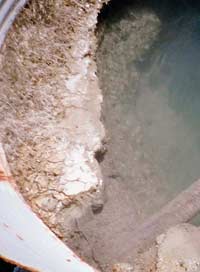Hot springs microbe yields record-breaking, heat-tolerant enzyme
By By Robert Sanders | 07 Jul 2011
Bioprospectors from the University of California, Berkeley, and the University of Maryland School of Medicine have found a microbe in a Nevada hot spring that happily eats plant material – cellulose – at temperatures near the boiling point of water.
 |
| A 94°C geothermal pool, with a level-maintaining siphon, near Gerlach, Nevada. Sediment from the floor of this pool was enriched on pulverized miscanthus at 90°C and subsequently transferred to filter paper in order to isolate microbes able to subsist on cellulose alone. (Credit: Joel Graham, University of Maryland) |
In fact, the microbe's cellulose-digesting enzyme, called a cellulase, is most active at a record 109 degrees Celsius (228 degrees Fahrenheit), significantly above the 100? (212?) boiling point of water.
This so-called hyperthermophilic microbe, discovered in a 95? (203?) geothermal pool, is only the second member of the ancient group Archaea known to grow by digesting cellulose above 80?. And the microbe's cellulase is the most heat tolerant enzyme found in any cellulose-digesting microbe, including bacteria.
''These are the most thermophilic Archaea discovered that will grow on cellulose and the most thermophilic cellulase in any organism,'' said coauthor Douglas S. Clark, UC Berkeley professor of chemical and biomolecular engineering. ''We were surprised to find this bug in our first sample.''
Clark and coworkers at UC Berkeley are teaming with colleagues, led by Frank T. Robb, at the University of Maryland (U-Md) School of Medicine in Baltimore, to analyze microbes scooped from hot springs and other extreme environments around the United States in search of new enzymes that can be used in extreme industrial processes, including the production of biofuels from hard-to-digest plant fiber. Their team is supported by a grant from the Energy Biosciences Institute (EBI), a public-private collaboration that includes UC Berkeley, in which bioscience and biological techniques are being applied to help solve the global energy challenge.
''Our hope is that this example and examples from other organisms found in extreme environments – such as high-temperature, highly alkaline or acidic, or high salt environments – can provide cellulases that will show improved function under conditions typically found in industrial applications, including the production of biofuels,'' Clark said.






























